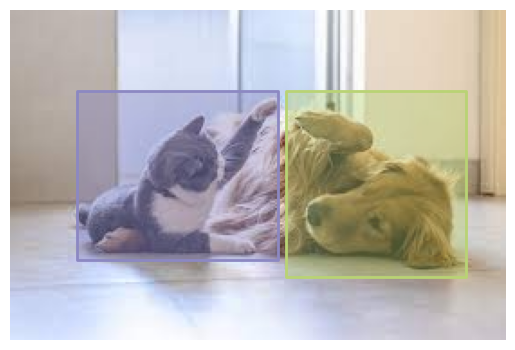Demo of bboxconverter
This notebook demonstrates the use of the bboxconverter package.
Converting bbox from CSV
In this example, we will convert a csv file containing bounding boxes in the format tlwh to tlbr and cwh formats.
import bboxconverter as bc
# Input file path
input_path1 = '../examples/csv_convert_demo/example1_tlwh.csv'
# Output file path
output_tlbr = '../examples/csv_convert_demo/example1_tlbr.csv'
output_cwh = '../examples/csv_convert_demo/example1_cwh.csv'
# Mapping between the input file and the bboxconverter format
bbox_map = dict(
class_name='class',
file_path='name',
x_min='top_left_x',
y_min='top_left_y',
width='w',
height='h',
image_width='img_size_x',
image_height='img_size_y',
)
# Read the input file
parser = bc.read_csv(input_path1, mapping=bbox_map)
# Export the file to the desired format
parser.to_csv(output_path=output_tlbr, type='tlbr')
parser.to_csv(output_path=output_cwh, type='cwh')
print(f"File saved to {output_tlbr} and {output_cwh}")
File saved to ../examples/csv_convert_demo/example1_tlbr.csv and ../examples/csv_convert_demo/example1_cwh.csv
Exporting to popular formats (COCO, VOC, YOLO) from Manifest
In this example, we will convert a file containing bounding boxes in popular format like COCO, VOC and YOLO formats.
import bboxconverter as bc
# Input file path
input_path2 = '../examples/manifest_export_demo/example.manifest'
# Output file path
output_coco = '../examples/manifest_export_demo/coco.json'
output_pascal_voc = '../examples/manifest_export_demo/pascal_voc.xml'
output_yolo = '../examples/manifest_export_demo/yolo.txt'
# Configuration of the manifest file
config = {
'labelling-job-name': 'crh-label-test5',
'labelling-job-metadata': 'crh-label-test5-metadata',
}
# Read the input file
parser = bc.read_manifest(input_path2, configuration=config)
# Export the file to the desired format
parser.export(output_path=output_coco, format='coco')
parser.export(output_path=output_pascal_voc, format='voc')
parser.export(output_path=output_yolo, format='yolo')
Not implemented yet
Not implemented yet
Preparing a COCO dataset
In this example, we will prepare a COCO dataset using bboxconverter package.
In this example, we have the following files and folders:
imagesfolder containing imagescat_dog.csvfile containing bounding boxes intlwhformat
We will convert the cat_dog.csv file to COCO format and save it in coco.json file.
Furthermore, we will also split the dataset into train and validation sets including the images as well.
import bboxconverter as bc
# Input file path
input_path2 = '../examples/csv_prepare_coco_dataset/cat_dog.csv'
# Output file path
output_coco = '../examples/csv_prepare_coco_dataset/coco.json'
# Mapping between the input file and the bboxconverter format
bbox_map = dict(
class_name='rectanglelabels',
file_path='file_name',
x_min='x',
y_min='y',
width='width',
height='height',
image_width='original_width',
image_height='original_height',
)
# Read the input file
parser = bc.read_csv(input_path2, mapping=bbox_map)
# Export the file to the desired format
parser.export(output_path=output_coco, format='coco', split=True)
Displaying bounding boxes
In this section we will display bounding boxes on images using pycocotools package.
import skimage.io as io
import matplotlib.pyplot as plt
import numpy as np
from pycocotools.coco import COCO
# Load COCO annotations
workdir = '../examples/csv_prepare_coco_dataset/train'
annFile = f'{workdir}/train.json'
coco = COCO(annFile)
cats = coco.loadCats(coco.getCatIds())
nms = [cat['name'] for cat in cats]
print(f'COCO categories: \n{" ".join(nms)}\n')
# Get all images containing given categories, select one at random
catIds = coco.getCatIds(catNms=['cat', 'dog'])
imgIds = coco.getImgIds(catIds=catIds)
img = coco.loadImgs(imgIds[np.random.randint(0, len(imgIds))])[0]
# Load and display image
I = io.imread(
f'{workdir}/{img["file_name"]}'
)
plt.imshow(I)
plt.axis('off')
annIds = coco.getAnnIds(imgIds=img['id'], catIds=catIds, iscrowd=None)
anns = coco.loadAnns(annIds)
coco.showAnns(anns, draw_bbox=True)
loading annotations into memory...
Done (t=0.00s)
creating index...
index created!
COCO categories:
cat dog
